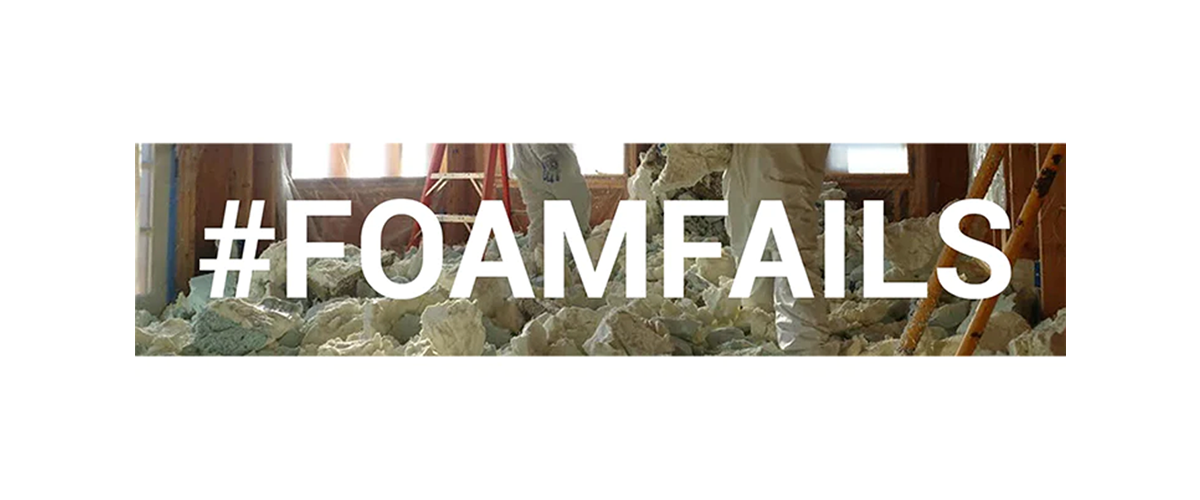Unhealthy Off-Gassing & Dust
Spray foam produces two forms of toxins: continuous off-gassing and chemical dust.
As a two-component chemical system, spray foam is made by mixing Parts A and B. When the chemicals are prepared under the right conditions and precisely mixed, the chemicals will have a complete reaction. After the initial, noxious spraying and curing periods, they may eventually become inert. But, if not reacted fully, off-gassing will occur indefinitely, posing a continuous health hazard to occupants and sometimes producing a tell-tale odor.

Additionally, spray foam is commonly dislodged, cut, or trimmed during installation, creating noxious dust. Both dust and off-gassing from spray foam can be dangerous. To help mitigate this risk, installation workers are required to wear hazmat suits with full face and respirator protection, while also keeping the workspace properly ventilated.

Of course, spray foam can be unsafe for occupants too. According to the EPA, occupants must stay away from the building while it cures (and as long as the dust remains) for at least 24 to 72 hours, something they, devastatingly, are not always told. If the spray foam continues to off-gas, the building can be inhospitable to occupants for years. It can even result in “sick building syndrome”—plaguing occupants with acute to chronic illness—if occupied. Abandoning a residence can result in serious financial problems compounding already-existing health problems.
What are the alternatives?
Architects, engineers, consultants, and builders have tremendous power to choose high performance and safe building systems that not only do less harm, but actively create a better future. There are many different pathways to achieve this, but they all must do the following:
- Address occupant comfort, health, and safety
- Be sustainable and encourage biodiversity
- Produce negative carbon emissions
To that end, we've developed our Smart Enclosure System with nine assembly types available that completely eliminate foam from the equation.
Why Is Spray Foam Dangerous?
The short answer is that it's toxic! In our blog post, Why Foam Fails. Reason #1: Dangerous Toxic Ingredients, we noted that the high level of toxicity is well-documented.
MDI: The Known Hazard
Part A of spray foam is typically formulated from methylene diphenyl diisocyanate, or MDI. MDI is an allergen and sensitizing toxicant, and diisocyanates in general are known to cause asthma, lung damage, and even fatal reactions, according to the EPA. Once “sensitized” from exposure to MDI, even the smallest subsequent exposure can cause severe health effects.
Amines, Glycols, and Phosphate: The Unknown Hazards
In a CDC blog post, industrial hygienist David Marlow at the National Institute for Occupational Safety and Health (NIOSH) summed it up well:
"The hazards of MDI are well-documented and their exposure limits have been established. However, the known hazards for spray polyurethane foam only take into account the first part of the mixture—the MDI. The other half of the mix has not been studied for worker safety. It is a chemical question mark with no toxicology or health information. This part contains amines, which act as a catalyst; glycols—blowing agents that react with the foam; and phosphate, a flame retardant. This half of the spray polyurethane foam equation raises several questions..."
Without a complete understanding of the health risks posed by spray foam, one can assume it is as dangerous as MDI at best, and likely only more so.
Don’t Take It from Us
One family's ordeal was the subject of a Canadian Broadcasting Corporation Marketplace segment. After an attic spray foam job failed to cure, headaches, joint pain and swelling limbs sent one family member to the hospital. The persistent off-gassing forced the family to live for months in a temporary trailer next to their poisoned home until they were able to replace their entire roof and attic structure.
As indoor air quality expert Bernard Bloom notes in this radio segment on spray foam remediation, using spray foam is like playing Russian Roulette with your property. For those who’d rather not leave their home up to chance, we suggest following our simple spray foam rule: less is best.
So check out our Smart Enclosure System for the best, non-spray foam solutions for your project. And remember, build like the future depends on it.



